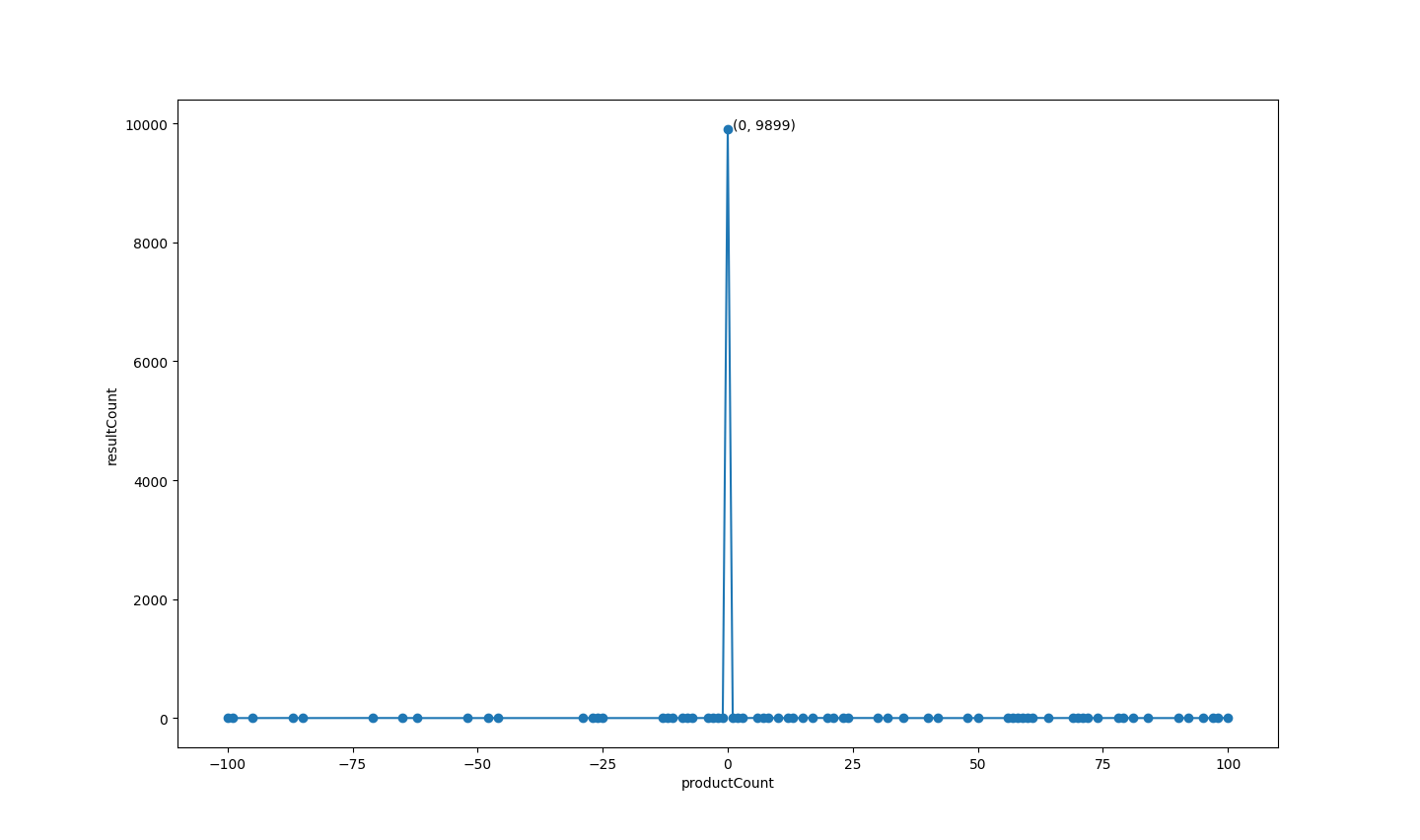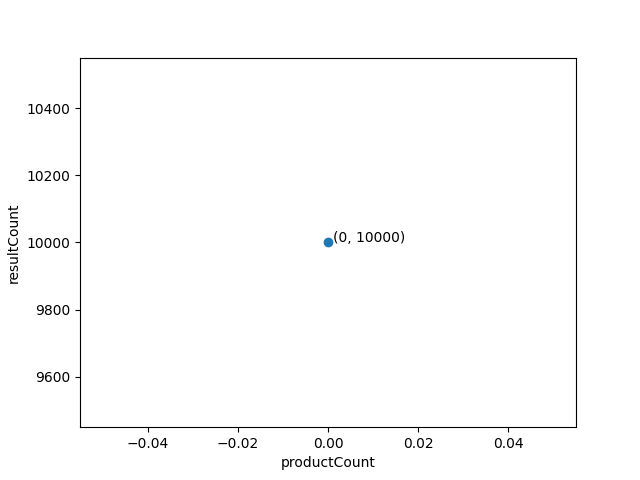多线程竞态,是指的多个线程同时访问/修改共享资源时,出现不可预知的结果。
单资源竞态
我们引入典型的生产者-消费者的场景:
- 产品个数:productCount;
- 生产者:生产1个产品,产品个数增加1;
- 消费者:消费1个产品,产品个数减去1。
其具体代码(C++)如下所示:
#include <cstdint>
#include <functional>
#include <iostream>
#include <thread>
using namespace std;
// 共享资源:产品个数
int32_t productCount = 0;
// 生产者:生产
void Produce()
{
productCount += 1;
}
// 消费者:消费
void Consume()
{
productCount -= 1;
}
// 创建两个线程,分别充当生产者和消费者
void ChangeProductCount(uint32_t runCount)
{
auto run = [=](function<void()> action) {
for (uint32_t i = 0; i < runCount; ++i) {
action();
}
};
thread producer(run, Produce);
thread consumer(run, Consume);
this_thread::sleep_for(chrono::milliseconds(1));
producer.join();
consumer.join();
}
int main()
{
ChangeProductCount(100);
cout << productCount << endl;
return 0;
}
上述代码,我们期望的结果应该是0,而且实际测试结果中大多数情况下都是0。该如何理解这个大多数呢?而且我也很好奇,这个运行结果应该是怎样的一个分布情况呢?
于是,我对上述代码main函数进行了一次改造,将实际多线程的函数运行了10000次。
/****************改造升级运行10000次,并统计结果值的分布************************/
void Statistic()
{
map<int32_t, int32_t> resultCount;
for (int32_t i = 0; i < 10000; ++i) {
productCount = 0; // 每次运行多线程前清零,避免干扰
ChangeProductCount(100);
resultCount[productCount]++;
}
for (auto& item : resultCount) {
cout << item.first << " " << item.second << endl;
}
}
int main()
{
Statistic();
return 0;
}
其运行结果统计信息如下图所示:

从上图可以很直观的看出来,这个所谓的大多数情况都是符合期望值0,只有少数不符合期望。正是由于我们所谓的大多数情况下都是正确的,就给我们大家造成一种“以前都是正确的,又没有改任何代码,怎么是我的代码造成的呢?”的错觉。
单资源竞态原因
其实,我们对一个变量运算,大体分为3个步骤,从内存读取到CPU、CPU计算、从CPU写回内存。一个线程完全没有问题,但是多线程情况下就有所不同了,比如下标所示,productCount默认值为0:
| 时间序列 | producer线程 | consumer线程 |
|---|---|---|
| 1 | 读取值0 | |
| 2 | 读取值0 | 计算:0 - 1 = -1 |
| 3 | 计算:0 + 1 = 1 | 写回:-1 |
| 4 | 写回:1 |
从上表可以看出2个问题:
- 生产1次,消费1次,结果却是1;
- 还没有产品,消费者却在消费。——此问题,不在此处的讨论范畴内。
单资源竞态解决方案
因为上述的三个步骤,不是一个原子步骤,就让多线程有机可乘。如果我们能保证上述3个步骤能在一个原子动作内完成即可保证最终结果符合期望了。
在上述代码中,将 productCount 改成一个原子变量即可。修改方法如下:
#include <atomic> // 增加原子头文件
atomic_int32_t productCount{0}; // 将原来普通变量,改为原子变量即可。
运行结果如下:

多资源竞态
如果在生产者-消费者场景中,增加单个产品的价格,考虑最终的收益:
- 产品个数:productCount;产品收益:productIncome;
- 生产者:生产1个产品,产品个数增加1,收益减少10;
- 消费者:消费1个产品,产品个数减去1,收益增加20。
其具体代码如下所示:
#include <atomic>
#include <cstdint>
#include <functional>
#include <iostream>
#include <map>
#include <mutex>
#include <string>
#include <thread>
#include <vector>
using namespace std;
// 打印互斥锁
mutex recordMtx;
vector<string> runInfos;
// 共享资源:产品个数,产品收益
atomic_int32_t productCount{0};
atomic_int32_t productIncome{0};
void Record(const string& name)
{
lock_guard<mutex> guard(recordMtx);
runInfos.push_back(name + " productCount:" + to_string(productCount) + " income:" + to_string(productIncome));
}
// 生产者:生产
void Produce()
{
productCount += 1;
productIncome -= 10;
Record("producer");
}
// 消费者:消费
void Consume()
{
productCount -= 1;
productIncome += 20;
Record("consumer");
}
// 创建两个线程,分别充当生产者和消费者
void ChangeProductCount(uint32_t runCount)
{
auto run = [=](function<void()> action) {
for (uint32_t i = 0; i < runCount; ++i) {
action();
}
};
thread producer(run, Produce);
thread consumer(run, Consume);
this_thread::sleep_for(chrono::milliseconds(1));
producer.join();
consumer.join();
}
int main()
{
ChangeProductCount(5);
for (auto& info : runInfos) {
cout << info << endl;
}
return 0;
}
运行结果如下:
producer productCount:1 income:-10
producer productCount:1 income:0
consumer productCount:2 income:0
consumer productCount:1 income:10
consumer productCount:0 income:30
consumer productCount:-1 income:50
consumer productCount:-2 income:70
producer productCount:-2 income:70
producer productCount:-1 income:60
producer productCount:0 income:50
上述代码例子中,借鉴了前面的例子,采用了原子变量的方式。虽说,运行结果符合期望,但是在运行过程中,是存在问题的,比如第3行,是生产者打印了2次,消费者打印1次,表示已经生产了2个消费1个,收入为0。但是,产品数量为2,收入却为0。
多资源竞态原因
虽说单个变量已经保证了读取、计算、写回这三个动作作为一个原子动作,但是多个变量的之间的联动未保持一致。如下表所示:
| 时间序列 | 生产者-产品个数 | 生产者-收入 | 消费者-产品个数 | 消费者-收入 | 产品个数 | 收益 |
|---|---|---|---|---|---|---|
| 1 | 生产:1 | 收益:-10 | 1 | -10 | ||
| 2 | 生产:1 | 收益:-10 | 消费:1 | 收益:+20 | 1 | 0 |
| 3 | 生产:1 | 2 | 0 | |||
| 4 | 收益:-10 | 2 | -10 |
多资源竞态解决方案:
加锁保护多资源,保证相关的多资源操作是一个原子的操作,避免某一个资源正在被操作时,被其他线程操作另外一个资源。因此,修改方法如下所示(不考虑仅有产品时,消费者才消费的场景):
#include <cstdint>
#include <functional>
#include <iostream>
#include <map>
#include <memory>
#include <mutex>
#include <string>
#include <thread>
#include <vector>
using namespace std;
// 资源互斥锁
mutex resMtx;
vector<string> runInfos;
// 共享资源:产品个数,产品收益
int32_t productCount{0};
int32_t productIncome{0};
void Record(const string& name)
{
runInfos.push_back(name + " productCount:" + to_string(productCount) + " income:" + to_string(productIncome));
}
// 生产者:生产
void Produce()
{
lock_guard<mutex> guard(resMtx);
productCount += 1;
productIncome -= 10;
Record("producer");
}
// 消费者:消费
void Consume()
{
lock_guard<mutex> guard(resMtx);
productCount -= 1;
productIncome += 20;
Record("consumer");
}
// 创建两个线程,分别充当生产者和消费者
void ChangeProductCount(uint32_t runCount)
{
auto run = [=](function<void()> action) {
for (uint32_t i = 0; i < runCount; ++i) {
action();
}
};
thread producer(run, Produce);
thread consumer(run, Consume);
this_thread::sleep_for(chrono::milliseconds(1));
producer.join();
consumer.join();
}
int main()
{
ChangeProductCount(5);
for (auto& info : runInfos) {
cout << info << endl;
}
return 0;
}
其运行结果如下:
producer productCount:1 income:-10
producer productCount:2 income:-20
producer productCount:3 income:-30
producer productCount:4 income:-40
producer productCount:5 income:-50
consumer productCount:4 income:-30
consumer productCount:3 income:-10
consumer productCount:2 income:10
consumer productCount:1 income:30
consumer productCount:0 income:50






















 2939
2939

 被折叠的 条评论
为什么被折叠?
被折叠的 条评论
为什么被折叠?








